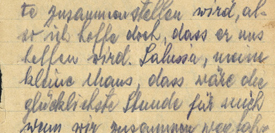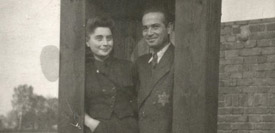Harry Haubenstock
 “We really saw very little of each other today, but my
“We really saw very little of each other today, but my
thoughts and feelings were with you all the time,
my sweet Sala.”
Harry Haubenstock was a Czech businessman who met Sala in October 1942 at Gross Paniow, Poland, one of the five Schmelt camps through which Sala moved quickly
in the summer and fall of 1942.
As the news from home grew more alarming and letters from family,
friends, and Ala decreased,
he provided emotional support for Sala, now 18 years old.
When many prisoners in the camp became sick with typhus, work was suspended and the camp quarantined. Sala and Harry remained healthy, and in this slightly relaxed atmosphere, they fell in love. From within the camp, Harry wrote affectionate letters in German to his “young bride,” describing his dreams of marrying her after the war. Aware that they were likely to be transferred soon, Harry worked successfully to keep them on the same transport, and they arrived together at Blechhammer, another Schmelt camp in Germany. However, after only a few weeks there, another transport loomed. Before they were separated, they promised to meet in Prague after the war.
 Harry Haubenstock and Sala Garncarz, October 1942
Harry Haubenstock and Sala Garncarz, October 1942Sala was sent to Schatzlar,
Czechoslovakia, and Harry to Dyhernfurth, Germany, to a former
Schmelt camp that produced poison gas, where he became part of the camp ’s Jewish leadership. For Sala’s birthday in March 1943, he sent her a letter and a photograph of the two of them taken in Gross Paniow, Harry’s yellow star clearly visible on his suit. By then, almost no correspondence was allowed in Schatzlar, yet Sala’s camp supervisor, charmed by Harry’s fluent German, let the letter through.
In the winter of 1944–45, with the German army in retreat, the Nazis ordered “death marches”—long, tortured walks in bitter cold without rest or food. Harry survived the Dyhernfurth death march and returned to Prague at the end of the war.
View section images